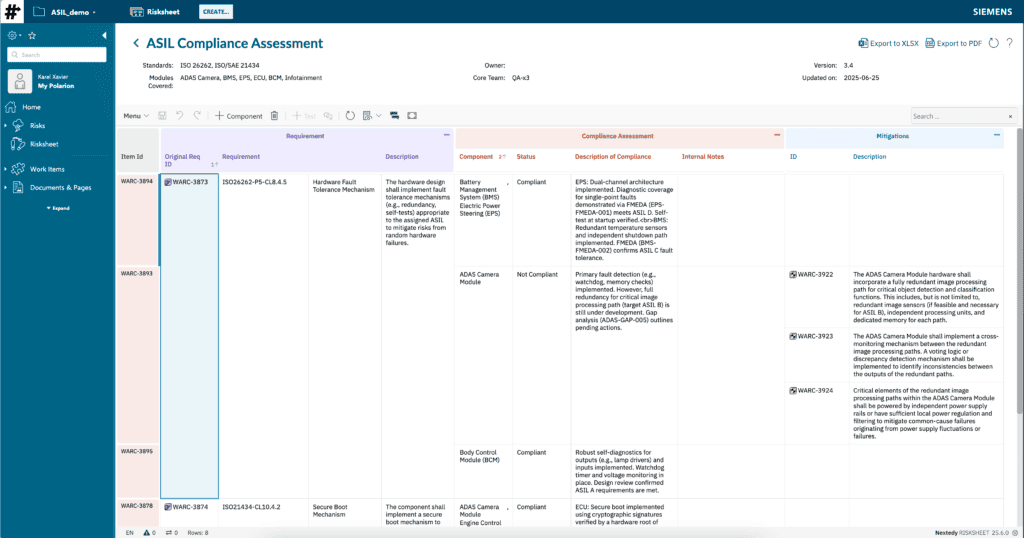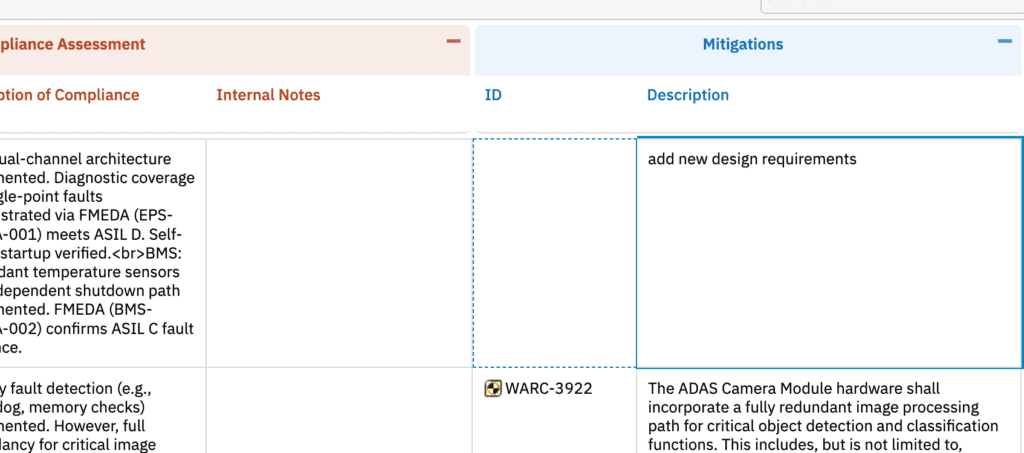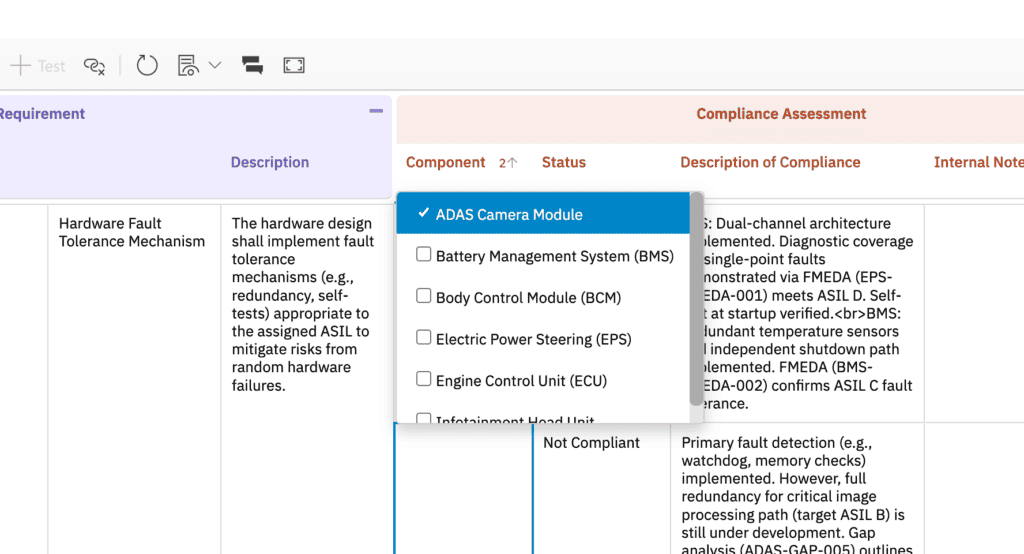Abstract:

In an environment of increasingly stringent regulations and complex product development, robust compliance management is paramount. Traditional approaches, often reliant on disconnected documents and manual tracking, struggle to provide the necessary traceability, actionable insights, and auditable evidence required by standards like ISO 26262, ISO/SAE 21434, and others. This whitepaper details how Siemens Polarion ALM, enhanced by Nextedy RISKSHEET, transforms compliance management from a reactive, burdensome task into a proactive, integrated, and transparent discipline. We will explore how this powerful combination creates a single source of truth for compliance requirements, their assessment against system components, and the management of corrective actions (mitigations), ensuring organizations can meet their obligations with unparalleled efficiency and confidence.
The Escalating Challenge of Compliance Management
Organizations, particularly in regulated sectors such as automotive, aerospace, medical devices, and critical infrastructure, face mounting pressures in compliance:
- Diverse and Evolving Standards: Managing requirements from multiple, often updated, international, industry-specific, and internal standards is a significant hurdle.
- Disconnected Documentation & Data Silos: Compliance evidence, requirement interpretations, assessment results, and mitigation plans are frequently scattered across various documents, spreadsheets, and isolated tools, leading to a fragmented view and audit nightmares.
- Manual, Error-Prone Assessment Processes: Manually tracking which requirements apply to which components, assessing compliance status, and linking evidence is time-consuming, prone to errors, and lacks dynamic visibility.
- Lack of Actionable Mitigation Tracking: Identifying non-compliance is only half the battle; ensuring that corrective actions (mitigations) are defined, assigned, tracked to completion, and verified is often a weak link.
- Overwhelming Audit & Reporting Burdens: Demonstrating adherence, providing end-to-end traceability from standard clause to implementation and evidence, and proving controlled processes can be an exhaustive undertaking.
- Inefficient Resource Allocation: Without a clear, real-time overview of compliance status and outstanding gaps, prioritizing efforts and allocating resources effectively becomes challenging.
Introducing Proactive Compliance Management: A Structured Approach
Effective compliance management involves systematically identifying applicable requirements from relevant standards (e.g., ISO 26262 for functional safety, ISO/SAE 21434 for cybersecurity), assessing how system components meet these requirements, and rigorously managing any deviations through corrective actions. This structured approach aims to:
- Establish Clear Traceability: Link specific clauses from standards to internal requirements, then to system components, their compliance status, and supporting evidence.
- Provide Objective Assessment: Systematically evaluate each requirement against relevant components.
- Ensure Actionable Corrections: When gaps are found, define, implement, and verify specific mitigations or corrective measures.
- Maintain an Audit Trail: Keep a comprehensive record of all compliance activities, decisions, and changes.
The Polarion + Nextedy RISKSHEET Advantage: Transforming Compliance into an Integrated Discipline
Achieving proactive compliance requires more than just good intentions; it demands deep integration into the Application Lifecycle Management (ALM) framework. The synergy of Siemens Polarion ALM and Nextedy RISKSHEET delivers this critical capability:
Unified Platform – Single Source of Truth for Compliance:
Eliminates data silos and document-centric chaos. Compliance Requirements (derived from standards or internal policies) and their assessments become managed Work Items within Polarion, coexisting with system requirements, design specifications, test cases, and project artifacts.
Nextedy RISKSHEET: Offers an intuitive, spreadsheet-like interface directly within Polarion (as seen in your “ASIL Compliance Example” example) to manage these Compliance Assessment records. This makes complex data, such as a requirement’s status across multiple components, easily visible and editable within the ALM.
Actionable Intelligence – Executable Mitigation Measures:
Moves beyond simply noting non-compliance. Mitigations are not just text descriptions in a report.
Nextedy RISKSHEET & Polarion: As shown in your sheet’s “Mitigations” columns (ID and Description), these corrective actions are defined as distinct, executable Polarion Work Items (e.g., types such as “Corrective Action,” “Design Change Request,” or new “System Requirements”). These are explicitly linked (e.g., via a “resolves” or “mitigates gap for” relationship) to the specific compliance gap. Each mitigation thereby has an owner, status, due date, and is tracked through established development and verification workflows.
Controlled Visibility & Collaboration – Granular Permissions:
Protects sensitive information related to compliance gaps or strategic responses, while enabling necessary collaboration.
Polarion’s Robust Permissions Model: Dictates who can view or modify specific Compliance Assessment details or linked Mitigations. Nextedy RISKSHEET operates entirely within these Polarion permissions, ensuring that, for instance, details of a critical non-compliance are accessible only to authorized personnel, vital for maintaining integrity and managing disclosures.
Structured Knowledge – Reusable Compliance Frameworks & Component Libraries:
Leverages existing knowledge, ensures consistency, and accelerates assessments for new projects or product variants.
Polarion Work Items as Catalogs: Standard clauses (e.g., ISO26262-P5-CL8.4.5 from your sheet) can be managed as a library of “Standard Requirement” Work Items. Similarly, “Components” (like ADAS Camera Module, Body Control Module) can be defined as reusable Work Items. RISKSHEET then facilitates the assessment of these standard requirements against these defined components.
Efficiency & Accuracy – Streamlined Assessment and Status Tracking:
Reduces manual effort, minimizes errors, and provides real-time visibility into compliance posture.
Nextedy RISKSHEET: Simplifies the process of assessing multiple components against a single requirement (as demonstrated in your sheet where a requirement like “Hardware Fault Tolerance Mechanism” is assessed for Battery Management System (BMS), Electric Power Steering (EPS) together, and separately for ADAS Camera Module). Updating Status (Compliant, Not Compliant) and Description of Compliance is straightforward.
End-to-End Traceability & Auditability – Provable Compliance:
Simplifies audits and provides irrefutable evidence of due diligence.
Polarion’s Core Strength: Every Compliance Assessment record, its link to the original standard requirement, the assessed components, the compliance status, the justification (Description of Compliance), linked mitigations, and all historical changes are versioned and auditable. This creates a clear lineage from standard -> requirement -> component assessment -> evidence/gap -> mitigation -> verification.
A Glimpse into the Compliance Workflow with Polarion and Nextedy RISKSHEET
The workflow leverages the strengths of both platforms:
- Phase 1: Compliance Requirement Definition & Scoping
- Relevant clauses from standards (e.g., ISO 26262, internal policies) are imported or defined as “Standard Requirement” Work Items in Polarion.
- The scope of assessment is defined, identifying which “Components” (also managed as Work Items) are subject to which requirements.
- Phase 2: Compliance Assessment via RISKSHEET
- Using Nextedy RISKSHEET, users assess each “Standard Requirement” against the scoped “Component(s).”
- The Status (e.g., Compliant, Not Compliant, Partially Compliant) is set for each component or group of components.
- The Description of Compliance field is populated with justifications, evidence references (e.g., links to test reports, design documents), or details of identified gaps. (e.g., “Primary fault detection … implemented. However, full redundancy … still under development. Gap analysis (ADAS-GAP-005) outlines pending actions.”)
- Phase 3: Mitigation Management (for Non-Compliance)
- If a Status is “Not Compliant” or “Partially Compliant,” new “Mitigation” Work Items are created directly from or linked within RISKSHEET.
- These Mitigations (e.g., WARC-3922, WARC-3923 from your sheet) describe the necessary corrective actions or design changes. They are assigned owners and tracked through Polarion’s workflow.
- Phase 4: Verification, Closure & Reporting
- Implemented Mitigations are verified.
- The Status of the corresponding Compliance Assessment in RISKSHEET is updated upon successful mitigation.
- Polarion’s reporting capabilities are used to generate compliance matrices, gap analyses, and audit reports.
Key Differentiators for Compliance Managers & Quality Leaders:
- Mitigations as Managed Work: Corrective actions are not lost in spreadsheets; they are fully managed Polarion tasks or requirements, integrated into development backlogs and verification cycles.
- Granular Component-Level Assessment: Clearly track the compliance status of each requirement for every relevant component, providing a precise understanding of the system’s overall compliance.
- Centralized Evidence Hub: The Description of Compliance field, coupled with Polarion’s linking capabilities, allows for a centralized way to reference and manage compliance evidence.
- Agile Compliance: As development progresses or standards evolve, assessments can be iteratively updated, and new mitigations tracked within the same integrated environment.
Conclusion: Elevating Compliance Management to a Strategic Advantage
For organizations striving for excellence in regulated industries, the combination of Polarion ALM and Nextedy RISKSHEET offers a paradigm shift in compliance management. It moves beyond the limitations of traditional methods by providing a unified, traceable, and actionable system. This solution empowers Compliance Managers, Quality Leaders, and development teams to proactively address regulatory demands, streamline audit preparations, and integrate compliance seamlessly into the product lifecycle. By transforming compliance data into structured, manageable, and actionable intelligence, organizations can not only meet their obligations but also turn robust compliance into a competitive differentiator.
To explore how Nextedy RISKSHEET can revolutionize your compliance management processes within Polarion, contact info@nextedy.com or request a personalized demonstration.




